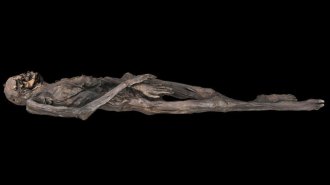Farmers took fast track in settling Europe
Archaeologists have for decades tried to pin down when the first farming communities appeared in Europe and how farmers spread across the continent to replace mobile groups of hunter-gatherers.
Radiocarbon data from southern European sites now unveil a lightning-fast colonization of this region by small farming groups, says Joo Zilho of the Portuguese Institute of Archaeology in Lisbon. The finding challenges views that have emphasized a gradual expansion of relatively large agricultural populations.
Radiocarbon dates for the first appearance of so-called Neolithic farmers at locations from Italy to Portugal cluster around 7,400 years old, Zilho reports in the Nov. 20 Proceedings of the National Academy of Sciences. “The rapidity of this spread [of farming] occurred over no more than six generations, or about 100 to 200 years,” he says.
Archaeological finds indicate that at around the same time, Middle Eastern farmers lived in heavily populated communities marked by class and social divisions. To escape the conflicts that presumably resulted, some of the farmers took boats westward along the Mediterranean coast and founded a series of small villages, Zilho theorizes. Rapid population growth in these settlements led to further migrations, in his view.
Zilho’s proposal hinges on a review of the latest radiocarbon dates for charred seeds, shell artifacts, wood charcoal, and animal bones at 22 Neolithic locations. These sites are in Mediterranean regions of Italy, France, Spain, and Portugal. The dates come from devices called accelerator mass spectrometers, which provide accurate age estimates from small samples.
Previous age estimates for the settlement of these sites ranged from as early as 8,000 years ago to around 7,000 years ago. However, those dates were derived from less-accurate analyses of bulk charcoal samples, Zilho says. Moreover, some of those charcoal samples came from Stone Age sediment that eroded into Neolithic layers, he contends.
“I think Zilho is on to something,” comments Peter A. Rowley-Conwy of the University of Durham in England. “We’re getting a better view of the rapidity with which small-scale movements [of farming groups] happened in Europe.”
Other radiocarbon data suggest that around 5,900 years ago, farmers spread from England into Scandinavia over just 200 years, Rowley-Conwy says.
DNA analyses, which have yet to be conducted on human bones at the Neolithic sites, will clarify the spread of agricultural groups, he adds.







